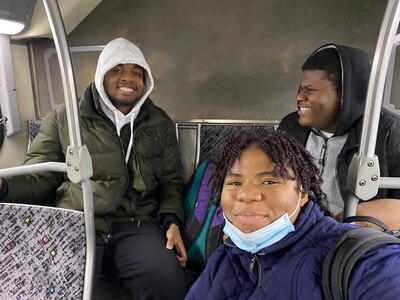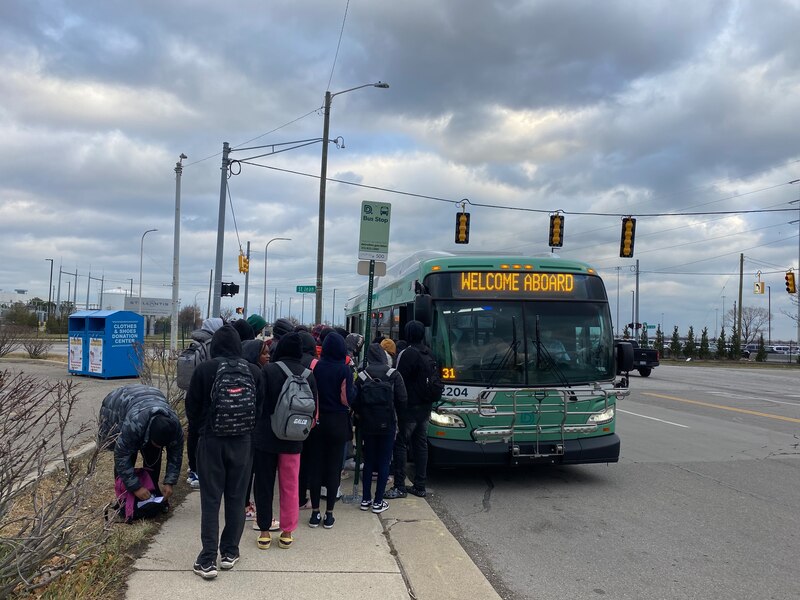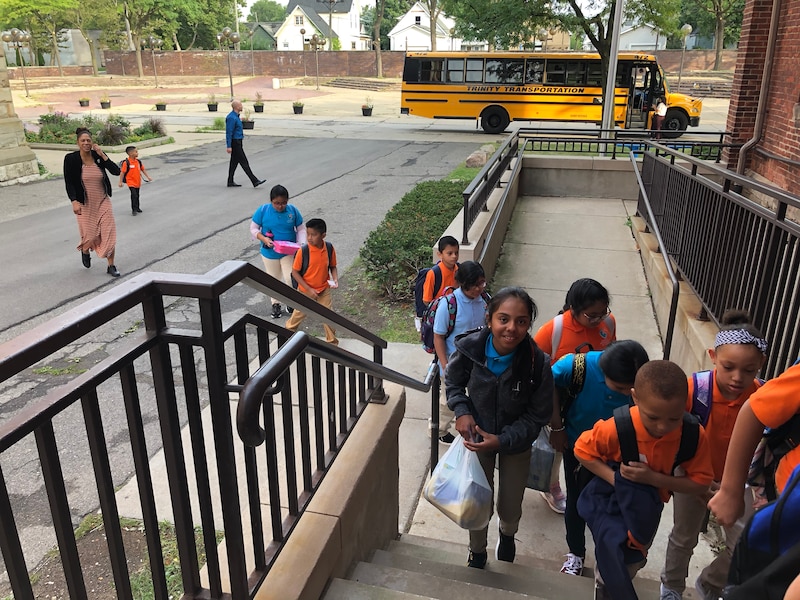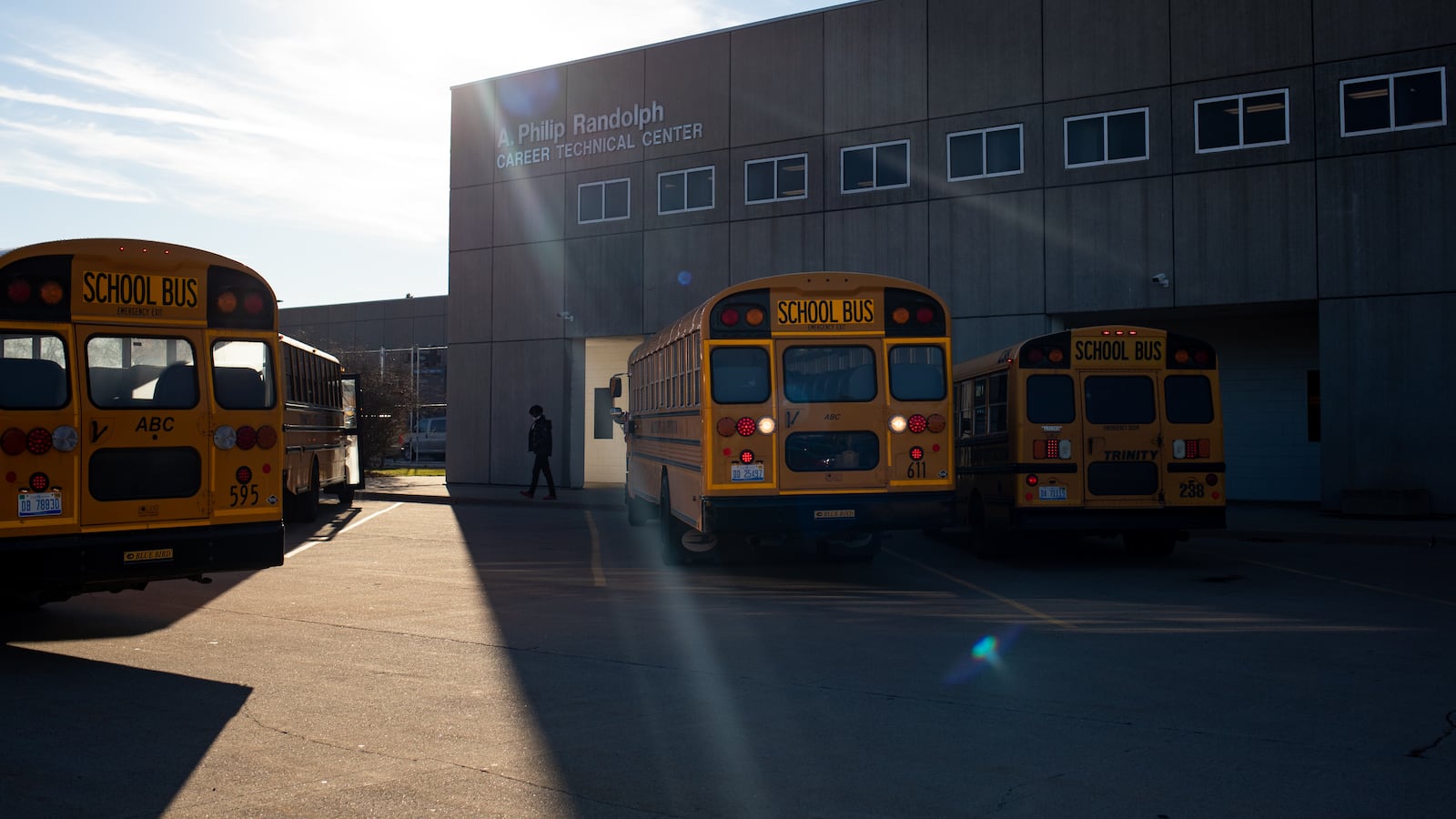On a chilly October morning, 12th-grader Jay Johnson walked toward the bus stop in the Bagley neighborhood, where he boards a Detroit city bus each day for the 11-mile trip to Martin Luther King Jr. Senior High School. At 6:18 a.m., he posted a photo on Instagram, letting his friends know that he was making his way to school.
As he waited on Seven Mile Road for the No. 7 bus, he stood under a streetlight to make sure he was visible to the bus driver. But the bus zoomed right past him. Johnson would have to wait for the next one, which, according to the Detroit transit app on his phone, wouldn’t arrive for 45 minutes.

Wait for 45 more minutes in the predawn gloom? No way, Johnson decided.
“It’s 6:30 in the morning, and it’s cold, and the bus passed me,” he recalled thinking. “I’m going home.”
He called his mom to let her know, and the school marked him absent for the day — a full day of instruction lost for a student who was up early, at the bus stop in time, and would have been at school, if only his ride had come through.
Thousands of students across Detroit are similarly vulnerable to being absent from school — and losing crucial instructional time — because of a transportation system that’s full of holes.
In the city that put America on wheels, basic transportation remains a pervasive challenge. One-third of residents don’t own cars. The Detroit Public Schools Community District provides only limited school bus service, and none at all to high school students, who instead get passes to ride city buses. Families in the city who choose charter schools, specialized “application” schools in the district, or other schools outside their neighborhoods often forgo their right to a school bus for their kids.
For large numbers of students, getting to school hinges on parents or family networks. Many more must rely on Detroit’s notoriously limited transit system, whose routes across the 143-square-mile city are designed to get people to job centers like hospitals and factories, not to school.
“Transportation is one of, if not the biggest barrier” to consistent student attendance in Detroit, said Sarah Lenhoff, a professor of education at Wayne State University and director of the Detroit Partnership for Education Equity and Research, which has published numerous studies of attendance barriers in Detroit. In interviews with Lenhoff’s team of researchers, Detroit parents reported that unreliable transportation prevented them from getting their children to school.
Pennia Anderson has spent years driving seven nephews, nieces and grandchildren to charter schools around Detroit.
“If something happens to the car, that kid’s not going to school,” she told Chalkbeat. “Who has money for an Uber?”
Lenhoff and other experts agree that transportation hurdles are not a root cause of chronic absenteeism. Rather, these hurdles amplify other drivers of absenteeism, such as housing instability, poverty, and chronic health problems, to make Detroit a “uniquely challenging context” for school attendance, Lenhoff’s group said in a 2019 report.
That cascade of factors helps explain why Detroit students miss school at a higher rate than their peers almost anywhere in the U.S., with grave consequences. Frequent absences interrupt classrooms, undercut school improvement efforts, and ultimately limit learning opportunities. Students who are chronically absent are more likely to struggle in school and drop out.
Families asked to fill transportation gaps
At least five states guarantee students transportation to school if they live farther than walking distance. And most K-12 students in Michigan can count on school bus service to school, although districts are not required to provide it. Even rural districts in some of the state’s poorest areas stretch their budgets to offer busing to all their students.
But in Detroit, funding shortages, closures of neighborhood schools, and expanded school choice have left fewer students with access to school buses, and shifted much of the burden of student transportation to families.
DPSCD provides school buses only to the 70% of K-8 students who live more than three-quarters of a mile from the neighborhood school they attend. Busing is not available to high schoolers, or to students who attend specialized application schools rather than their neighborhood schools.
All told, 24,000 students, more than half of students who attend district schools, are not eligible for a school bus, according to figures provided by Nikolai Vitti, DPSCD superintendent. That number doesn’t include thousands of students who are eligible for rides to their neighborhood school but who attend a different district school.
Citywide, another 47,000 students attend charter schools, which often offer little or no transportation.
Many Detroit parents go to extraordinary lengths to get their kids to class, driving long distances in some cases, spending for gasoline, and building their work schedules around dropoff and pickup times. But that may not be an option at all for families dealing with poverty or inflexible work schedules, or who don’t have a car.
For them, the options are limited. They can bike or walk, which may mean taking a dangerous route to school past abandoned homes or crossing major streets.
Or they can take the city bus, one of the nation’s least reliable and comprehensive big-city public transit systems, and hope it arrives on time.
High school students depend on limited city bus system
Brianna Davis, a 10th grader, depends on the city bus for the daily trip from her house in Garden Homes, at the northwestern edge of the city, to school at MLK, east of downtown.
And as Davis knows firsthand, the system is not designed with students’ schedules in mind.
To get to class in time for the first hour bell at 8:05 a.m., Davis leaves home by 5:55 a.m. Ideally, she catches the bus on Eight Mile Road around 6 a.m., then transfers to a second bus that’s scheduled to get her to school by 7:10 a.m. That gives her some wiggle room if a bus passes her or arrives late — both of which happen often, she says.
Driving the 12-mile trip to school would save at least a half hour each way, but her parents’ work schedules don’t allow for that.
What would she change about the bus system? “Start coming on time,” she said.
Detroit buses run late 44% of the time on weekdays, due in large part to driver shortages.
The city bus “is why my attendance is shot,” said Perriel Pace, an 11th grader at MLK. “I get up at 5 a.m., and I still get to school late.”

Even if the system did run on time, it still would pose challenges to students.
In interviews, high schoolers who use the bus said that the system does not appear to prioritize student riders through, for example, bus stop placements, route timing, and bus frequency around school release time.
At Southeastern High School, dozens of students walk a quarter mile to the bus stop, where many wait in a liquor store parking lot. Miss the bus, and students have to wait 30 minutes for the next one.
At another bus stop in Detroit, a group of students leaving an after-school tutoring program at University Preparatory Academy High School told a Chalkbeat reporter they had been waiting an hour before a bus appeared — and drove right past them.
Moreover, students say, they don’t feel safe riding a city bus with adults.
“People do drugs on the bus,” said Ashton Crist, a freshman at Cass Technical High School, as he waited for a bus in December. “It’s not a good place for kids to be.”
Mikel Oglesby, the city’s executive director of transit, said in a statement that improving service to schools is “one of the important guiding principles” of the Detroit Department of Transportation’s plan to rethink bus service across the city. “Bus stops are located in close proximity to schools where feasible and where safe paths to schools are present,” he said.
While the plan hasn’t been released yet, a recent outline of its priorities does not mention students or schools. Oglesby noted that the department will be taking feedback on its proposals in public meetings, though none will be specifically dedicated to the needs of families.
Relying on the transit system poses challenges for student attendance, but there’s no question that it saves the Detroit district money. In a typical year, the district spends about $200 on average for each high school student who uses a bus pass, including summer school students. The district’s spending for yellow buses — which includes daily transportation for K-8 students, as well as field trips, sporting events, and shuttles to vocational education centers — amounts to about $1,900 per student.
That helps explain why many other big-city districts — including New York, Los Angeles, and Philadelphia — shift older students to public transit and give them passes, or do away with school busing entirely.
But those cities have much more comprehensive and better-funded public transit systems than Detroit, with longer operating hours, interconnected rail and bus networks, and more frequent runs.
More school choice, less access to school buses
The Detroit Public Schools Community District offers most K-8 students transportation to their neighborhood public schools, noting that if it failed to do so, “absenteeism rates would increase and enrollment would decline.”
But in Detroit, only a fraction of students attend their neighborhood public school.
Over the last 30 years, the state has moved aggressively to give families educational choices besides their neighborhood school, including charter schools and traditional public schools outside their home district. As Michigan encouraged competition between districts, choices proliferated primarily in Detroit and other majority-Black cities, where declining enrollment, instability, and widespread school closures alienated many families.
Asked why they chose schools that required long, complex commutes, numerous students gave Chalkbeat different versions of the same answer: When the alternative is a school in their neighborhood with high teacher turnover and low academic performance, there’s not much choice at all.
In Detroit, where parents have a huge number of schools to choose from, roughly half of students attend charter schools or other districts bordering Detroit, most of which provide little or no transportation. Even within the main city district, about one-third of students go to a school outside their neighborhood, forgoing their right to transportation.
Davis is one example. When she got into MLK, her parents decided that it was worth the commute because they viewed it as a better academic option than the alternative closer to home.
Tara Fields, whose first-grader attends University Preparatory Academy Elementary School, a charter in Detroit, said fitting the 20-minute school commute around a work schedule is “a little hectic sometimes.” She says she is luckier than many parents because she has a car.
“It’s a good school, so that’s worth it,” she added.

Solutions go beyond transportation
Closing Detroit’s transit gaps wouldn’t cure its student absenteeism problem.
“It’s inaccurate to think transportation is the root cause of absenteeism or that by expanding transportation alone absenteeism will dramatically improve,” Vitti wrote in an email.
He says the root cause of absenteeism is poverty and its symptoms — housing instability, car trouble, medical problems, and a lack of support networks that help people manage small problems like medical appointments, changing work schedules, and car trouble.
Lenhoff agrees that transportation should be viewed in the context of the various factors that drive absenteeism, including parents’ work schedules.
Consider that K-8 classes in the city typically start around 8:30 a.m., and end around 3:30 p.m.
“We’ve interviewed many parents whose children miss school because they have to be at work before school starts, and they don’t have transportation for them after they leave for work,” Lenhoff wrote in an email.
A bus might help if the child could stay home alone, she said, but “another solution could be to create a before-care program at the school, so parents could drop their children off early before they go to work. It’s a transportation problem solved by child care.”
The district is piloting expanded before- and after-care programs with this kind of situation in mind. And the GOAL Line, a popular but small after-school program with a transportation component, is aiming to expand again.
Many families already fill child care gaps using private programs for school-age children, which can be costly.
Still, several Detroiters told Chalkbeat that just a school bus would go a long way.
Fields, the charter school parent, said sending her child to school by bus “would be a wonderful thing. That’s one less step” to keep track of every day.
Providing adequate busing to every student in the state would likely cost $400 million, according to a plan presented by school finance experts last year. While that package is designed to help rural schools manage their disproportionately high transportation costs, it could also help DPSCD expand its bus service.
Vitti cautioned, however, the district is also struggling with bus driver shortages, which could slow any effort to expand bus service.
Koby Levin is a reporter for Chalkbeat Detroit covering K-12 schools and early childhood education. Contact Koby at klevin@chalkbeat.org.
Editor’s note: March 22, 2023: The story was updated to more clearly define who is eligible for school bus service in the Detroit district.

